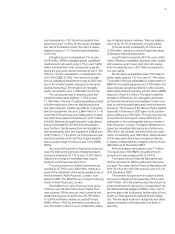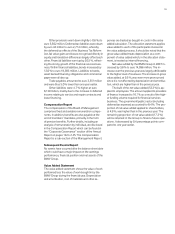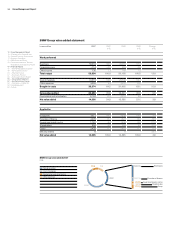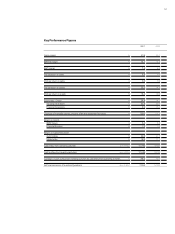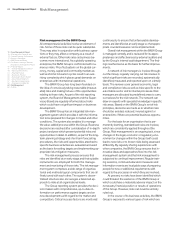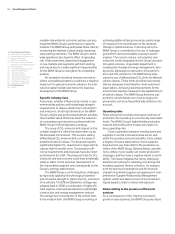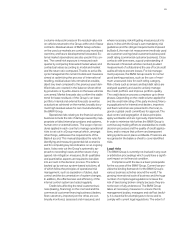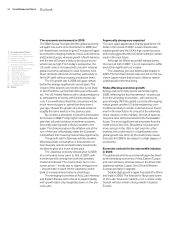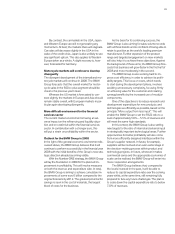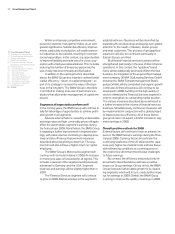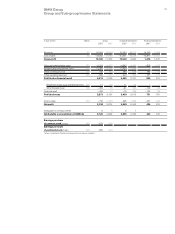BMW 2007 Annual Report Download - page 65
Download and view the complete annual report
Please find page 65 of the 2007 BMW annual report below. You can navigate through the pages in the report by either clicking on the pages listed below, or by using the keyword search tool below to find specific information within the annual report.63
addressed below. Additional comments on risks in
conjunction with financial instruments are provided
in note [38] of the consolidated financial statements.
Risks relating to the general economic
environment
As a globally operating enterprise, the BMW Group
is affected by global economic factors such as
changes in currency parities and changes on the
financial markets. The US dollar is particularly impor-
tant for the development of Group revenues and
earnings and represents the greatest individual risk
within the BMW Group’s foreign currency portfolio.
Exchange rate fluctuations of the Japanese yen, the
British pound and the Chinese renminbi in relation
to the euro can also have a material impact on earn-
ings. Based on Group forecasts, these four curren-
cies account for some 75 % of the foreign currency
exposure of the BMW Group.
The BMW Group manages currency risks at
both a strategic and an operating level. From a stra-
tegic point of view, i.e. in the medium and long term,
the BMW Group endeavours to manage foreign ex-
change risks by natural hedging, in other words by
increasing the volume of purchases denominated
in foreign currency or increasing the volume of local
production. In the short to medium term (i.e. for
operative purposes), currency risks are hedged on
the financial markets. Hedging transactions are en-
tered into only with financial partners of first-class
credit standing. The nature and scope of such meas-
ures are set out in guidelines applicable throughout
the BMW Group. A cash-flow-at-risk model and sce-
nario analyses are used to measure exchange rate
risks. These instruments are also used as part of
the process of currency management for the purpose
of taking business decisions.
The BMW Group reduces currency risk by re-
financing its financing and lease business as a gen-
eral rule in the currency of the relevant market. If
funds are raised in a foreign currency, swap con-
tracts are concluded immediately afterwards in the
corresponding local currency in order to reduce the
risk exposure.
Liquidity and interest-rate risks are managed
within the BMW Group by raising refinancing funds
with matching maturities and by employing deriva-
tive financial instruments. Interest-rate risks are
measured and limited both at a country and Group
level on the basis of the value-at-risk concept. The
risk-return ratio is also measured regularly using sim-
ulated computations in conjunction with a present
value-based interest-rate management system.
Sensitivity analyses, which contain stress scenarios
and show the potential impact of interest rate changes
on earnings, are also used as tools to manage
interest-rate risks. Credit lines with various banks
and the use of various financing instruments ensure
sufficient liquid funds are available to the Group. Li-
quidity risk is continuously monitored at a separate
entity level and documented in a rolling cash flow
forecasting system.
A major part of financing and lease business
within the Financial Services segment is refinanced
on the capital markets. As a result of its good credit
standing, reflected in the long standing first-class
short-term ratings issued by Moody’s (P-1) and
Standard & Poor’s (A-1), the BMW Group is able to
obtain competitive conditions. The long-term ratings
for the BMW Group published by Standard&Poor’s
and Moody’s in September 2005 remain unchanged,
also helping the BMW Group to obtain competitive
conditions. Moody’s issued an A1 rating and S & P
an A+ rating, both with stable outlook. As a con-
sequence of the general crisis of confidence on the
financial markets, financing conditions also deterio-
rated for the BMW Group in the second half of 2007,
despite the good ratings that it enjoys.
Changes in the international raw material mar-
kets also have an impact on the business develop-
ment of the BMW Group. In order to safeguard the
supply of production materials and to minimise
the cost risk, the commodity markets relevant for
the BMW Group are closely monitored. The market
price trend of precious metals such as platinum,
palladium and rhodium, for which appropriate hedg-
ing strategies are decided upon by the Raw Mate rials
Committee, is also important in this context.
Changes in the price of crude oil, which is an
important basic material in the manufacture of
com-
ponents, have an indirect impact on production costs.
As a manufacturing enterprise, the BMW Group is
also affected by changes in energy prices, caused by
both market factors and tax legislation.
Cyclical economic fluctuations also represent
risk factors for future business development. Unfore-


